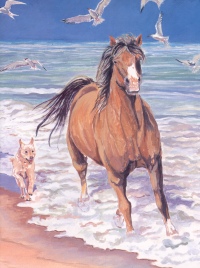| ________________
CM . . .
. Volume XIII Number 21 . . . . June 8, 2007
excerpt:
Free as the Wind is a fictional account of the historic events of the 1960s in which a letter-writing campaign of school children across Canada saved the wild horses of Sable Island from being killed for dog food. In the story, Lucas Beauregard, a boy of nine or ten years of age, lives with his family on Sable Island, off the southeast coast of Nova Scotia, where he spends his days admiring the majestic wild horses of the island. When Lucas learns from his father that the government has ordered all of the horses to be rounded up for auction and slaughter, Lucas tries to think of a way to free the horses permanently. As he watches the horses being unloaded and sold in Halifax, Lucas gets the idea to write a letter to Prime Minister John Diefenbaker to plead with him to release the horses back into the wild where they belong. The rest of the students at Lucas' school also write letters, and, in a short time, Lucas receives a letter from the Prime Because the events of this story are described through the eyes of a young boy, the language used in this present-tense first-person narrative is relatively simple. Events are seen as a young child might interpret them: straightforwardly incorporating thoughts, sounds, and dialogue. Yet, while the first-person voice encourages the reader to easily become a part of the action, the sporadic oscillation between thoughts, sounds, and dialogue in relation to this voice causes the reader to experience disjointed understanding of the events as they take place. From each page to the next, the story progresses with episodic choppiness, as details connecting scene to scene seem to be omitted. For example, one morning, Lucas' father tells him of the latest news:
Much of the choppiness may be due to the constraints of telling a detailed story within the limits of the picture book format; this story seems to highlight key points from the original event that are the vital pieces that resulted in the release of the wild horses, according to history. The reader's understanding of how to connect these various episodes is helped only by the well-written synopsis, given on the book's inside cover, of the real historical events on which this story is based. If the reader does not read this synopsis prior to reading the story, natural understanding may be initially fairly limited. Lucas, although a young boy, feels emotions deeply. Throughout the text, however, his tone of voice changes back and forth between young and innocent – "I want to run up and stroke her neck instead, but Dad holds my shoulders" – to mature and burdened – "'Don't worry. I promise I'll get you back home soon.' Gem simmers down and whinnies…Just don't ask me how I'm going to do it." These conflicting tones make Lucas' character seem inconsistent and, therefore, somewhat unbelievable. Nonetheless, his voice constantly conveys the passion he feels for the horses' right for free life.
Susan Tooke's illustrations are the strength of this book as they add richness and vibrancy to the story. Using the combination of acrylic paints on watercolour paper, she extends the simple text by using flowing lines and rich colour combinations to evoke the emotions of joy and sadness that the story describes. Some images display the horses' wild and powerful spirit while others vividly capture the life of the Canadian people in the 1960s. Lucas comes alive as Tooke illustrates him with large emotive eyes and strong, realistic actions. Truly, the illustrations give life to this text and help to bring history into the present for the reader. Free as the Wind provides a tangible example to young readers of how their small ideas can make a large difference in the world around them. This point is made clearly, yet refreshingly understatedly: the letter-writing idea is conceived of, acted on, and responded to, and the horses go free – all without Lucas becoming an over-glorified hero. This book has potential as a doorway to further exploration of the history behind the story. However, because of the story's episodic choppiness and tone inconsistency, the storyline cannot flow easily enough for the reader to spend little time filling in the gaps. Therefore, as it stands presently as a work of fiction, this book is recommended with reservations. It might perhaps be more useful to read the true account in a history textbook. Recommended with reservations. Shari Klassen is an early-years Bachelor of Education student at the University of Manitoba in Winnipeg, MB.
To comment on this
title or this review, send mail to cm@umanitoba.ca.
Copyright © the Manitoba Library Association. Reproduction for personal
use is permitted only if this copyright notice is maintained. Any
other reproduction is prohibited without permission.
NEXT REVIEW |TABLE OF CONTENTS FOR THIS ISSUE
- June 8, 2007. AUTHORS
| TITLES | MEDIA REVIEWS
| PROFILES
| BACK ISSUES
| SEARCH | CMARCHIVE
| HOME |

